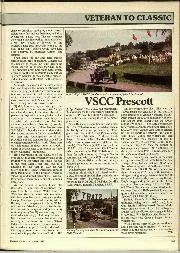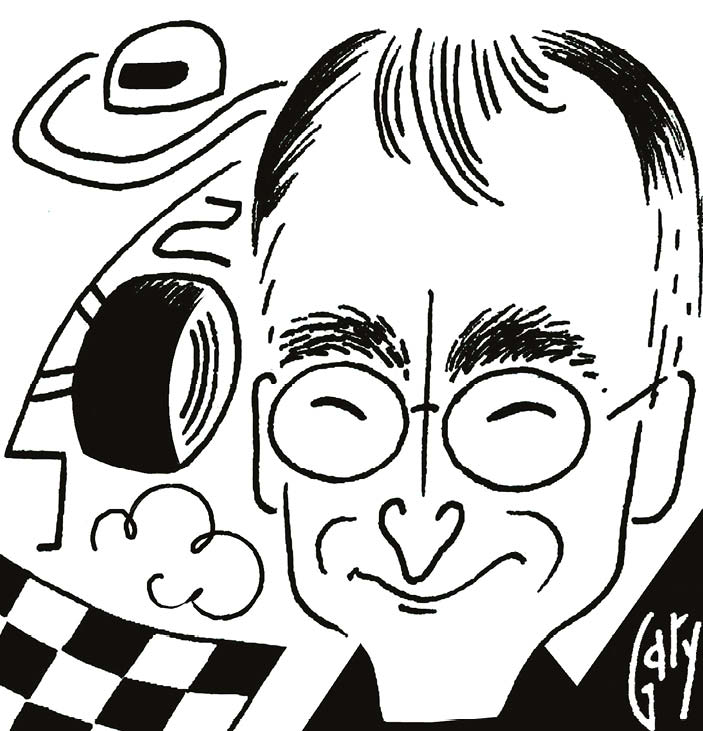
Veteran to classic
VSCC Prescott On august 7 the VSCC had magnificent weather for the anniversary celebration of its first Prescott hill-climb 50 years ago – and with the sun shining there is…

It probably began in F1 sometime around the turn of the ’80s; the idea that safety advances allowed some drivers to feel at liberty to use their car as an instrument of intimidation. The cars themselves were much safer than just a decade earlier and the worst excesses of the tracks upon which they raced had been taken away.
Think back to the Montréal title decider of 1980 when Alan Jones turned across the bows of Nelson Piquet at the old first corner (a fast right kink). Piquet had the option of backing out or staying with it, betting that Jones was bluffing. He did, he wasn’t. Jones explained that if another car was not in his peripheral vision, he’d behave as if it wasn’t there. That was his brand of etiquette. It would likely have got him or someone else killed a couple of decades earlier.
With the advent of carbon fibre, cars became yet safer – and Ayrton Senna took on the full implications in his determination to prevail over his nemesis Alain Prost. “Ayrton’s problem is that he always believes God will look after him,” said Prost, when hostilities between them were such that Senna tried to pin Prost’s car towards the Estoril pit wall flat out in top, with pit boards having to be quickly pulled up from where the Frenchman had been forced to drive. The purest expression of the philosophy came with his enraged reaction to being denied the faster side of the grid after setting pole for Suzuka 1990. It was a travesty of justice, but his reaction was extreme. Who can forget the sight of him failing even to lift, let alone brake, for the first corner once Prost had beat him off the line? This was no longer just the racing car as an instrument of threat, but as an actual weapon.
Michael Schumacher was perhaps less pre-meditated in his dangerous fouls, often triggered in moments of competitive panic. But they were deliberate fouls, all the same – against Damon Hill at Adelaide and Jacques Villeneuve at Jerez most famously, but any number of times off the grid when trying to keep another car behind. That was a very significant watershed. Largely as a result of Schumacher unilaterally declaring his own terms of combat, the first serious attempt was made at writing a regulation to control that, with the early ’90s ‘one move’ rule. That is where it all began to go wrong. That’s what led us to Sebastian Vettel’s ludicrous 5sec penalty in Montréal that destroyed a thriller of a race. If instead of writing rules, we’d simply used the black flag more readily, racing in F1 would be a much freer, more intuitive thing without the need for the legalese which is sucking the very life out of the sport.
Because that ‘one move’ rule was just the beginning. As time went by, the authorities attempted to incorporate pretty much every racing situation into words defining what you can and can’t do – and with a code system of penalties set accordingly. The race stewards became tasked during and after the race with looking at video replays of incidents to decide if it broke the wording of any of those rules. If it was deemed they had, the stewards had no choice but to impose the appropriate penalty.
“If we used the black flag more readily, racing in F1 would be a freer thing ”
This sort of thing used to be covered by a code of behaviour among the drivers. Attempting to incorporate this into words – rather than consistently using the black flag to anyone contravening that code – was where the trouble started. Any wording always creates loopholes, an invitation to find a way around the wording. As soon as you define in words what is legal, an obvious competitive reaction is, ‘So anything not in the wording is legal?’ On this basis, behaviour that would never have been considered before was being unintentionally invited. So chopping ruthlessly across another car at 200mph (Schumacher on Mika Häkkinen Spa 2000, or Max Verstappen on Kimi Räikkönen, Spa 2016) was OK because it didn’t break the one-move rule. But running wide off the circuit, losing time and scrabbling to rejoin before the guy behind can pass is not OK because it could be deemed that he had not rejoined in ‘a safe manner’ (as per Vettel in Montréal). There is a requirement that the driver should leave a defined amount of track as he rejoins, which Vettel didn’t – as he was trying to keep control of his car after sliding across the grass and hitting a big kerb as he rejoined. The code demanded a 5sec penalty, thereby ruining what had been an epic 50-lap struggle.
“I sympathise in a way with the stewards,” said Vettel after he’d calmed down. “I’ve said many times when I’ve been in there that they are sitting in front of a piece of paper and they’re watching the race and they say, ‘We agree but look, we have to do these things.’ It’s just our times; we have regulations for everything. So we end up talking about racing situations like lawyers. It’s not the sport I fell I love with.”
Strip the regs back, dump the obligation to apply rules just because they are there, have an ex-racer referee with a let-them-race mentality. His decision will be final regardless of all arguments and he’ll come down hard and without mercy on anyone taking advantage of that leniency through driving deliberately dangerously. By way of a simple black flag: come in, switch off your engine, get out of the car, you’re finished for the day. Then the code of etiquette would decide how things flowed.
Since he began covering Grand Prix racing in 2000, Mark Hughes has forged a reputation as the finest Formula 1 analyst of his generation
Follow Mark on Twitter @SportmphMark